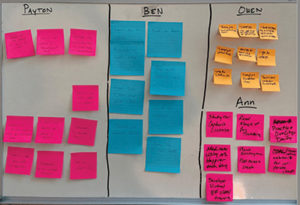Know What They Need: Help Your Child Recharge and Review This Summer
Ann Dolin, MEd
Download PDF
 As we enter summer break after more than a year of pandemic learning, you might feel pulled in opposite directions. On the one hand, your child hasn’t been in a traditional school setting for over a year. Students are likely behind where they would have been without the challenges of distance learning. On the other hand, your family is probably burned out and exhausted by the demands of digital learning. What’s a parent to do?
As we enter summer break after more than a year of pandemic learning, you might feel pulled in opposite directions. On the one hand, your child hasn’t been in a traditional school setting for over a year. Students are likely behind where they would have been without the challenges of distance learning. On the other hand, your family is probably burned out and exhausted by the demands of digital learning. What’s a parent to do?
In this article, I’ll help you learn how to strike the balance between learning and leisure by keeping your child engaged with both unstructured learning activities and intentional study time. With these techniques, you can help your child get ready to begin the next school year on track and ready to learn.
Start by getting children engaged
One of the best ways to engage children with ADHD is by including them in brainstorming activities and letting them choose an unstructured learning activity they’re interested in pursuing. The first step is to call a family meeting. Keep it light and fun. Give each family member a stack of Post-it notes and a marker. Ask two questions: “What do you want to do with your summer?” and “What are you interested in learning?”
Set a timer for four minutes and ask everyone to write down their ideas on the Post-it notes. When the timer goes off, everyone stops writing. One at a time, everyone shares what they wrote down, then sticks their notes to a wall, whiteboard, or poster. After sharing, each person picks out their top three ideas, shares with the group, and moves the Post-its to the top of their list. Cheer each other on and have fun!

BEN: Learn to weld and make a lamp
OWEN: Research and camp at Spruce Knob
ANN: Study for boating license
OTHER EXAMPLES FOR YOUNGER KIDS:
Research, budget, purchase hamster
Build a garden
Create an outdoor mural from wood slabs
You may wonder if this activity is successful with both older and younger kids. I wondered that myself. I did this activity many years ago with my sons, now 22 and 18 years old, but I wanted to try it again now that they’re older. A lot of time has passed, so I worried they wouldn’t be as engaged. Fortunately, I can say I was thrilled with the results.
Not only have I seen my own sons do this activity, but I’ve also been fortunate to see the results from other families. Let me tell you, children and parents come up with all kinds of things. From getting outdoors to owning a hamster, the goals your child comes up with engage them in learning—and help you get to know their interests.
Make space for traditional learning
Let’s take a closer look at some tools for engaging your child in traditional learning: reading, writing, and math.
Reading
Using DEAR time—which stands for “Drop Everything and Read”—can help kids with ADHD who struggle with reading motivation. DEAR time should last between twenty and thirty minutes, and can happen anytime during the day. After DEAR time, have your child to tell you about what they read. Not only will this help with their reading retention, but it also makes reading a shared event. If every day feels too daunting, pick a more manageable goal. Every little bit helps!
If you have an especially reluctant reader, try using audiobooks or reading along with them to pique their interest. Audio books are a great alternative to traditional reading and are even better if your kid reads along while listening. Reading along with your child can help them with fluency as you model reading.
Writing
Next, let’s talk about writing. Even if your child is intimidated by writing, there are things you can do to help build their writing confidence. YouTube is a great resource and makes helping kids with writing fun and easy.
For example, YouTuber John Spencer makes interactive, entertaining videos to help kids learn writing strategies and develop their skills. Spencer’s videos are a great kicking-off point for brainstorming, organizing, and putting pencil to paper.
Remember, writing isn’t just for older kids. You can also practice writing with your younger kids by creating a handwriting station to practice letter shapes and fine motor skills. Even if it’s just for ten minutes a day, writing practice goes a long way.
Math
If there’s one subject parents dread practicing with their kids over the summer, it’s math. Math is a cumulative subject, so each skill builds on the next and if your child hasn’t done math in six months, they may struggle with new concepts. Fortunately, there are many ways for you to incorporate math time into your kid’s day.
Opportunities to practice math are all around us. Look to integrate math into whatever you’re already doing during the day, like measuring ingredients. With younger kids, set up “stores” and “restaurants” to practice addition and subtraction. Get creative!
While there are tons of math activities that make summer learning fun, there’s also nothing wrong with using workbooks. Workbooks can help children master foundational skills in lower grades and even more difficult skills in upper grades. With younger kids, don’t worry so much about quality and accuracy. Encourage the activity itself without stressing over the outcomes.
Consider online learning resources
Applications and websites can be a great alternative to workbooks, especially when a topic is complex. The software can actually help teach the topic, making learning easier for both students and parents.
Here are two of my favorite online resources for traditional learning:
- BrainPOP (5th Grade and Up) or BrainPOP Junior (Elementary)
BrainPOP provides holistic learning on a variety of subjects. For example, if you’ve got a math-loving daughter, she might like to explore coding. The program uses videos, interactive lessons, and quizzes to help kids practice their language arts skills and build on their content knowledge. - IXL Learning | IXL.com
IXL.com covers many subjects, but the highlight is its math program. With its adaptive learning platform, the software recognizes when your child is having difficulty with a task and goes back to reteach the concept. It costs about $5 a month per subject, but I think the ability to be hands-off with your child’s math practice is well worth it.Both of these programs are great for kids with ADHD because they’re fast moving and colorful, which helps to keep your child engaged and interested.

Establish a summer routine
When will you do all of these learning activities? I recommend setting up a summer routine. Using a routine with kids with ADHD helps set expectations, avoid pushback, and develop good habits. It doesn’t need to be a strict schedule like it was during the school year, but the semblance of a routine is helpful.
Kids with ADHD do better with looser routines that use a reward after learning. For example, you can say, “By 9:00 everybody’s up, taking showers, and eating breakfast. Around 10:00, we’ll start working on learning.” Keep learning in short bursts and schedule it before other activities like playing video games. Spending just 15-20 minutes on a skill each morning will make a huge difference in your child’s confidence and knowledge come fall.
After the learning time, they get a reward, which could be watching TV, working on their Post-it note goal, or another activity they enjoy doing. Both of those things should be done in the morning and definitely completed by lunch.
As you plan for your summer routine, plan for a bedtime routine as well. This is helpful for children with ADHD, even during the summer. With older kids and teens, it can be hard to enforce strict bedtimes. You may have better luck with asking them to get up at a specific time in the morning, even if it’s 10:00 or 11:00. What we don’t want is for our high schoolers to sleep until 1:00 in the afternoon.
Getting your child to set aside time for summer learning nearly every day may feel impossible, but the tools and strategies I’ve shared can help.
Stay flexible, stay engaged
At the end of the day, let’s keep in mind that our kids have been through a lot in the past year. They really do need time to rest and do things that bring them joy. To accommodate that, you may find it helpful to relax some of your typical rules for the summer.
Kids are also craving meaningful social interaction, so fight to stay engaged with them this summer. Try to sit down and share family time when possible. You can share highs and lows from your day or use tools to get the conversation started, such as a jar I saw on Amazon called “Kids’ Daily Dilemmas.” This is an opportunity to connect and invite everyone to chime in.
By remaining flexible and engaging often, you can make this summer as positive as possible, even after what’s possibly been the most challenging year of your child’s life so far. By setting aside a little time for some summer learning each day, you can combat learning loss and set your child up for success next year—and beyond.
 Ann Dolin, MEd, president and director of Educational Connections (https://ectutoring.com), is a recognized expert in education and learning disability issues. She holds a BA in child psychology/elementary education and a master’s degree in special education, with a concentration in learning disabilities, from Boston College. Dolin is a former Fairfax County, Virginia, public school teacher with over twenty years of teaching and tutoring experience. She sits on the editorial advisory board of CHADD’s Attention magazine and on the board of the International Dyslexia Association. She has delivered hundreds of presentations focusing on academic achievement and parenting issues, and is the author of the award-winning book Homework Made Simple: Tips, Tools and Solutions for Stress-Free Homework.
Ann Dolin, MEd, president and director of Educational Connections (https://ectutoring.com), is a recognized expert in education and learning disability issues. She holds a BA in child psychology/elementary education and a master’s degree in special education, with a concentration in learning disabilities, from Boston College. Dolin is a former Fairfax County, Virginia, public school teacher with over twenty years of teaching and tutoring experience. She sits on the editorial advisory board of CHADD’s Attention magazine and on the board of the International Dyslexia Association. She has delivered hundreds of presentations focusing on academic achievement and parenting issues, and is the author of the award-winning book Homework Made Simple: Tips, Tools and Solutions for Stress-Free Homework.
Other Articles in this Edition
Is ADHD Related to Creativity?
LEAP: Promoting a Healthy Lifestyle
ADHD and the Myth of the Bad Parent
Know What They Need: Help Your Child Recharge and Review This Summer
Disclose Your ADHD? What to Consider First
Your Strengths Are Your Superpowers
